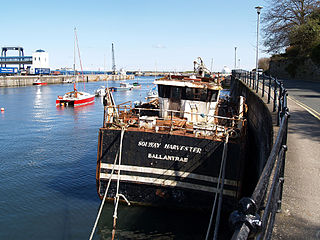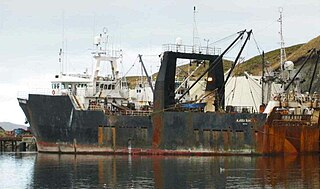Related Research Articles

RMS Empress of Ireland was a British-built ocean liner that sank near the mouth of the Saint Lawrence River in Canada following a collision in thick fog with the Norwegian collier Storstad in the early hours of 29 May 1914. Although the ship was equipped with watertight compartments and, in the aftermath of the Titanic disaster two years earlier, carried more than enough lifeboats for all aboard, she foundered in only 14 minutes. Of the 1,477 people on board, 1,012 died, making it the worst peacetime maritime disaster in Canadian history.
The fishing vessel Gaul was a deep sea factory ship based at Hull, United Kingdom. She was launched in December 1971 by Brooke Marine of Lowestoft, entering service during 1972 with the Ranger Fishing company, where she was registered at North Shields as Ranger Castor, SN18. She was renamed when Ranger Fishing was bought by British United Trawlers and re-registered at Hull as Gaul, H243. She sank some time on the night of 8–9 February 1974 in storm conditions in the Barents Sea, north of Norway. No distress signal was received and her loss was not realised until 10 February after she twice failed to report in. An extensive search operation was launched but no trace of the ship was found, apart from a lifebuoy recovered three months later. All thirty-six crew were lost. The president of the British Trawler Federation described the loss of the Gaul as "the worst ever single-trawler tragedy". The wreck was finally located in 1997.

Asgard II was the Irish national sail training vessel, until she sank in the Bay of Biscay in 2008. A brigantine, she was commissioned on 7 March 1981 and purpose-built as a sail training vessel by Jack Tyrrell in Arklow, County Wicklow. She was named after the Asgard, a yacht which smuggled weapons for the Irish Volunteers in 1914.

A fishing vessel is a boat or ship used to catch fish and other valuable nektonic aquatic animals in the sea, lake or river. Humans have used different kinds of surface vessels in commercial, artisanal and recreational fishing.

A factory ship, also known as a fish processing vessel, is a large ocean-going vessel with extensive on-board facilities for processing and freezing caught fish or whales. Modern factory ships are automated and enlarged versions of the earlier whalers, and their use for fishing has grown dramatically. Some factory ships are equipped to serve as a mother ship.

The Solway Harvester was a scallop dredger from Kirkcudbright, Scotland which sank off the coast of Douglas, Isle of Man in heavy seas on 11 January 2000 with the loss of all seven crew members. Following salvage, the damaged ship was taken to Douglas, where she remained until dismantled for scrap in January 2014.

FV Alaska Ranger was a fishing factory ship owned and operated by the Fishing Company of Alaska of Seattle, Washington. The ship was constructed in 1973 for use as an oil field service vessel. The ship sank 23 March 2008, after reporting progressive flooding only hours earlier. Of the 47 on board, 42 were rescued. Of the five fatalities, four were recovered dead, and one was never found. The Coast Guard was initially misinformed about the number of persons on board the vessel, and secured the search with one crew member still unaccounted for. After realizing there was still one person missing, the Coast Guard reinstated the search, but did not find the crew member.
The Hull triple trawler tragedy was the sinking of three trawlers from the British fishing port of Kingston upon Hull during January and February 1968. A total of 58 crew members died, with just one survivor. The three sinkings brought widespread national publicity to the conditions in which fishermen worked, and triggered an official inquiry which led to major changes to employment and working practices within the British fishing industry.
Marc Guylaine was a Canadian herring seiner built in 1969, along with its two sister ships, the Lady Dorianne and Lady Audette. After its two sister ships both mysteriously sank in the Acadian peninsula, drowning nine men, and the only two other ships built to the same specifications met identical fates, the Marc Guylaine became the subject of great fear that it would meet a similar end.

MFV Bugaled Breizh is a French trawler from Loctudy, Finistère, whose sinking with all hands in 90 metres of water in the English Channel on 15 January 2004 remains unresolved. While it appeared possible that the ship was pulled under by a submarine, a specific submarine could not be identified from among the number of submarines of several nations operating in the general vicinity of the accident site. Moreover, the condition of the ship's recovered trawling equipment was reported by a technical inquiry to not be consistent with a submarine entanglement.

Koraaga was a Castle-class steel-hulled trawler built in 1914 by Smith's Dock Company, South Bank, Middlesbrough. She was requisitioned as an auxiliary minesweeper operated by the Royal Australian Navy (RAN) in October 1917 for minesweeping duties during World War I, but she was never commissioned. Koraaga returned to be operated commercially as a fishing trawler until she wrecked when she struck a reef off Bass Point whilst carrying returning to Sydney. She was refloated on the tide after having becoming stranded and drifted till she was finally lost five miles (8.0 km) east of Black Head, Gerringong on 10 September 1931.

The 2002 West Bengal cyclone was a deadly tropical cyclone that affected India and Bangladesh in November 2002. The sixth tropical cyclone and fourth cyclonic storm of the 2002 North Indian Ocean cyclone season, it developed in the Bay of Bengal northeast of Sri Lanka on November 10, as a tropical depression. After tracking northeast, the system strengthened into a cyclonic storm on November 11, as maximum sustained winds exceeded 65 km/h (40 mph). On November 12, it further intensified into a severe cyclonic storm. Later that day, the storm made landfall on Sagar Island in West Bengal with winds of 100 km/h (60 mph). After moving inland, it rapidly weakened and dissipated over Bangladesh on November 12.

STV Astrid was a 41.90-metre long tall ship that was built in 1918 in the Netherlands as a lugger and originally named W.U.T.A., short for Wacht Uw Tijd Af meaning "Bide Your Time". She was later transferred to Swedish ownership, renamed Astrid and sailed on the Baltic Sea until 1975. She then sailed under a Lebanese flag and was allegedly used for drug smuggling. After being found burnt out on the coast of England in the early 1980s, she was overhauled and used as a sailing training vessel. She was based in Weymouth, Dorset, United Kingdom and was informally known as "Weymouth's vessel".
The Russian-flagged fishing trawler Dalniy Vostok sank on 1 April 2015, off Russia's Kamchatka Peninsula in the Sea of Okhotsk. Fifty-seven of the ship's 132 crew members were confirmed dead, with rescue operations underway for survivors. The freezer trawler sank 183 nautical miles west of Krutogorovsky, a settlement in Kamchatka's Sobolevsky District.

The Spanish fishing trawler Sonia sank off the Cornish coast of England on 20 October 1984. On 19 October, in Irish territorial waters off the coast of County Wexford, the Sonia had been spotted by the Irish Naval Service patrol vessel Aisling and was suspected to be fishing illegally. The Sonia was ordered to halt and prepare to receive a boarding party, but did not comply.

MS Estonia sank on Wednesday, 28 September 1994, between about 00:50 and 01:50 (UTC+2) as the ship was crossing the Baltic Sea, en route from Tallinn, Estonia, to Stockholm, Sweden. The sinking was one of the worst maritime disasters of the 20th century. It is one of the deadliest peacetime sinkings of a European ship, after the Titanic in 1912 and the Empress of Ireland in 1914, and the deadliest peacetime shipwreck to have occurred in European waters, with 852 lives stated at the time as officially lost.
The fishing vessel Antares was a pelagic trawler based in Carradale, Kintyre in the United Kingdom. She was fishing off the coast of the Isle of Arran on 22 November 1990 when she foundered with the loss of four crew members after her trawl line was snagged by Royal Navy Trafalgar class nuclear powered submarine HMS Trenchant. An investigation by the Marine Accident Investigation Branch concluded that the accident had been caused by "a partial breakdown in both the structure and the standards of watchkeeping on board Trenchant".
References
- ↑ "Details of Pere Charles UID #030058526". Fisheries and Aquaculture Department. Retrieved 2013-11-24.
- 1 2 3 "Tragedy at sea: Pere Charles was 'one of the finest in the fleet'". Irish Independent. 2007-01-12. Retrieved 2013-11-24.
- ↑ "Capsizing and Listing". European Maritime Safety Agency. Archived from the original on 2013-12-03. Retrieved 2013-11-24.
- ↑ Kane, Conor (2008-11-04). "Fateful trawler with five crew was too heavy, finds investigation". Irish Examiner . Retrieved 2013-11-24.
- ↑ "'Pere Charles' skipper was 'fully competent and conscientious'". Munster Express. 2008-06-20. Retrieved 2013-11-24.
- ↑ "Details emerge of draft Pere Charles report". RTÉ News. 20 June 2008. Retrieved 2013-11-24.
- ↑ Kane, Conor (2007-11-10). "Interior of Pere Charles trawler to be examined". Irish Examiner . Retrieved 2013-11-24.